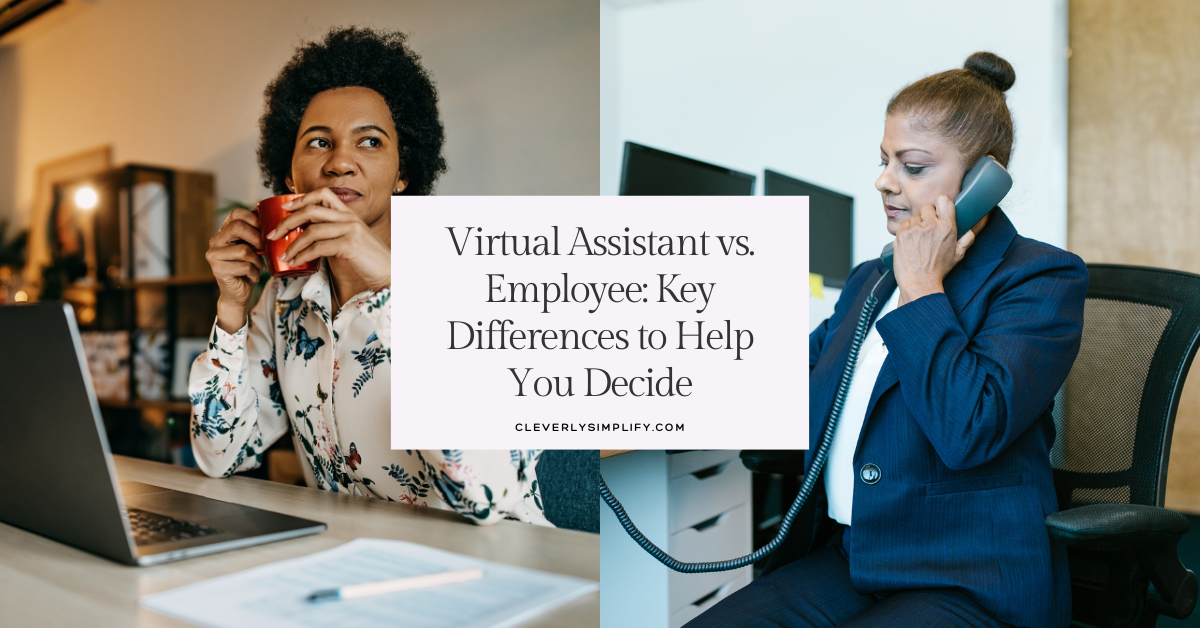Virtual Assistant vs. Employee: Key Differences to Help You Decide
Posted on | Debbie Fanfan |

As a small business owner, you’ve got a lot on your plate—managing clients, growing your business, and tackling a mountain of tasks. When it comes to getting help, you might be wondering: should I hire a Virtual Assistant (VA) or bring on an employee? It’s a big decision that can shape how your business operates and grows.
I’m here to break it down for you. Let’s explore the key differences, benefits, and drawbacks so you can choose the option that works best for you.
Cost Comparison: Virtual Assistant vs. Employee
Let’s talk money—because that’s usually the first question, right?
- Virtual Assistant: With a VA, you pay only for the services or hours worked—no hidden costs, no overhead for benefits, and no need to provide equipment. It’s simple, straightforward, and budget-friendly.
- Employee: Hiring an employee comes with a bigger financial commitment. Think salaries, benefits, taxes, sick leave, and equipment costs. It adds up quickly and can strain your budget, especially if your business is just starting out.
If saving money and keeping things flexible sound good, a VA might be your perfect match.
Location Flexibility: The VA Advantage
Where your help is based matters more than you might think.
- Virtual Assistant: VAs work remotely—they could be across town or halfway around the globe. This gives you access to a world of talent and expertise without geographic limits.
- Employee: While remote work is more common now, employees often need to be local or able to commute to your office, which can narrow your talent pool.
If flexibility and tapping into a broader range of skills sound ideal, a VA checks all the boxes.
Schedule and Availability: Tailored vs. Fixed Hours
- Virtual Assistant: VAs work on a schedule that fits your needs. Whether it’s part-time, project-based, or a few hours here and there, they adapt to you. Plus, many VAs offer flexibility to accommodate different time zones or urgent tasks.
- Employee: Employees stick to a more traditional schedule, typically 9-to-5. While predictable, this setup might not align with your business if you need more dynamic or on-demand support.
A VA’s adaptability is a game-changer for entrepreneurs juggling varied demands.
Benefits and Drawbacks of a Virtual Assistant
Benefits:
- They bring diverse skills to the table—everything from managing your inbox to creating killer social media posts.
- You only pay for the work done—no idle time, no wasted dollars.
- They use their own tools and equipment, cutting down on your expenses.
- You can hire them short-term, long-term, or as-needed. Total flexibility.
Drawbacks:
- Communication might not be daily or in-person, which can feel different if you’re used to face-to-face.
- Trust is key—you’ll need to rely on their time management and productivity.
- There’s a learning curve as they get familiar with your systems and processes.
Benefits and Drawbacks of an Employee
Benefits:
- Daily interaction builds trust and helps things flow more smoothly.
- Employees often develop a deeper understanding of your business over time.
- On-site presence means quicker responses to urgent situations.
Drawbacks:
- Costs—hiring, onboarding, and retaining an employee can be expensive.
- Fixed wages mean you’re paying regardless of productivity levels.
- Scaling up or down isn’t as easy as with a VA.
Which Option is Right for You?
At the end of the day, the choice between a Virtual Assistant and an employee depends on your business’s needs, goals, and budget. For many small business owners, a VA offers the perfect balance of flexibility, expertise, and cost-efficiency.
I’ve been there, and I get it. If you’re ready to explore how a Virtual Assistant can make your life easier, let’s talk. At Cleverly Simplify, I specialize in helping women entrepreneurs and online service providers streamline their businesses so they can focus on what truly matters.
Let’s Simplify Your Business Together
If a Virtual Assistant sounds like the right fit for you, let’s connect! Schedule a clarity call or explore my services today. Together, we can reclaim your time and elevate your business.
Your business deserves simplified, streamlined solutions—and I’m here to help.






